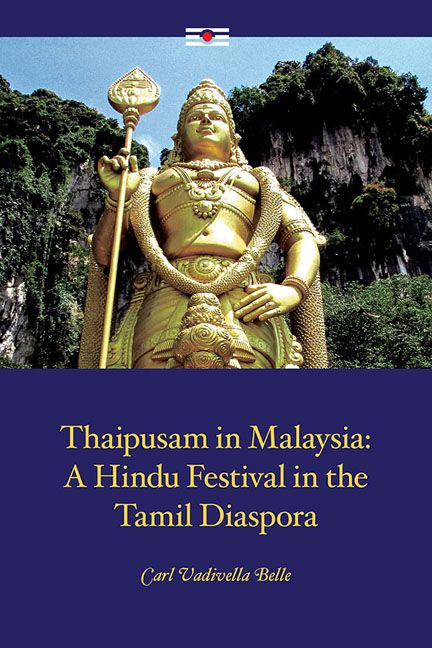Book contents
- Frontmatter
- Contents
- Acknowledgements
- Introduction
- 1 Indians in Malaysia: The Social and Ethnic Context
- 2 Tamil Traditions and South Indian Hinduism
- 3 Colonialism, Colonial Knowledge and Hindu Reform Movements
- 4 Hinduism in Malaysia: An Overview
- 5 Murugan: A Tamil Deity
- 6 The Phenomenology of Thaipusam at Batu Caves
- 7 Other Thaipusams
- 8 Thaipusam Considered: The Divine Crossing
- Conclusions
- Glossary
- Bibliography
- Index
- About the Author
1 - Indians in Malaysia: The Social and Ethnic Context
Published online by Cambridge University Press: 12 January 2018
- Frontmatter
- Contents
- Acknowledgements
- Introduction
- 1 Indians in Malaysia: The Social and Ethnic Context
- 2 Tamil Traditions and South Indian Hinduism
- 3 Colonialism, Colonial Knowledge and Hindu Reform Movements
- 4 Hinduism in Malaysia: An Overview
- 5 Murugan: A Tamil Deity
- 6 The Phenomenology of Thaipusam at Batu Caves
- 7 Other Thaipusams
- 8 Thaipusam Considered: The Divine Crossing
- Conclusions
- Glossary
- Bibliography
- Index
- About the Author
Summary
The large-scale migration of Indians to Malaya throughout the nineteenth century and the first few decades of the twentieth century led to the creation of a distinctively Malaysian Indian society. One of the most conspicuous features of this community is the sharp division between the minority upper classes — the middle, professional and commercial classes — and a majority working class which comprises over eighty per cent of Indian Malaysians. In general it may be claimed that this disjunction has its origins in the differing circumstances of each class's migration to Malaysia. Thus the descendants of “labour” recruitment — those who were contracted under indenture, kangany or other labour schemes, to work in the plantation estate sector or within government utilities — now make up an underclass which continues to fill a range of labouring and unskilled occupations within modern Malaysia. Conversely, the background of the middle and upper classes can generally be traced to “non-labour” migratory streams; that is, their forbears were those Indians who were appointed to clerical and technical positions in colonial Malaya, or who established themselves in professions and business. Most “non-labour” Indians maintain their social distance from “labour” Indians, and in some instances may even deny all bonds of common ethnicity.
While the earliest Indian labour throughout the colonial period was furnished by transported convicts, the overwhelming majority of Indian workers who arrived in Malaya between 1840 and 1910 were recruited under a system known as indenture. The colonial preference for South Indian labour was informed by an official perspective which viewed the “Madrassi” as docile and easily managed. Indeed, the supposed “cringingly servile” Tamil was portrayed both as an alternative and as a counterweight to the potentially ambitious and assertive Chinese worker. In his landmark study, K.S. Sandhu estimates that in this period a total of 250,000 indentured labourers were contracted to work in Malaya. These were mainly landless agricultural labourers drawn from the lower and Adi Dravida (Dalit) castes. The British government terminated the recruitment of Indian indentured labour to Malaya in 1910.
- Type
- Chapter
- Information
- Thaipusam in MalaysiaA Hindu Festival in the Tamil Diaspora, pp. 1 - 18Publisher: ISEAS–Yusof Ishak InstitutePrint publication year: 2017



